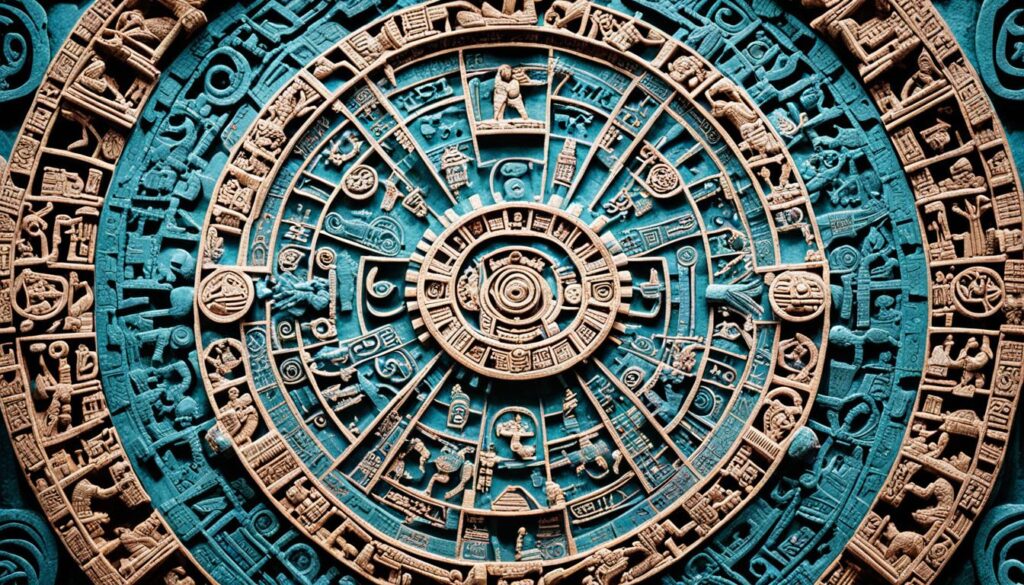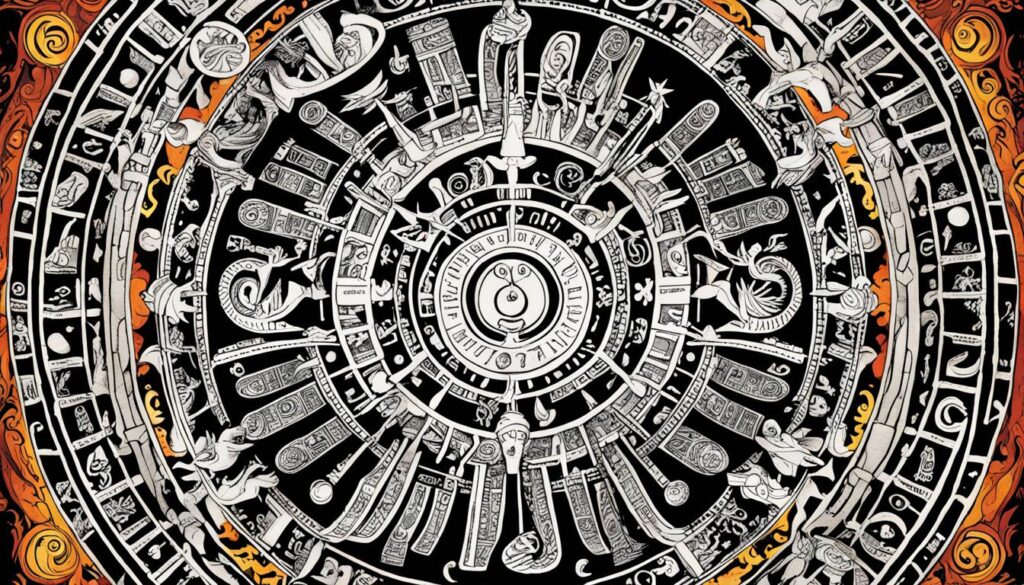The Maya civilization was a fascinating culture that lived in Mesoamerica. It is still captivating scholars and the public today. This ancient society thrived in what is now Mexico, Guatemala, Belize, El Salvador, and Honduras.
They are famous for their amazing achievements in architecture, math, astronomy, and writing. They also left behind mysteries that still puzzle us.
Their pyramids and temples in the Yucatán are awe-inspiring. They developed advanced math and astronomy systems. The Maya people show us how smart and advanced they were.
Even as we learn more about them, new discoveries keep coming. These discoveries help us understand the complex nature of the Maya culture.
Let’s explore the world of the Maya together. We’ll look at their amazing achievements, the puzzles they left behind, and their lasting impact on Mesoamerican history.
Exploring the Ancient Maya World
The Maya civilization is a fascinating part of Mesoamerican history. It started around the 1st century AD. The Maya people thrived for centuries, leaving a vast geographic reach and a cultural legacy that still inspires us today.
Origins and Geographic Reach
The Maya’s story began in the ancient Maya civilization. It covered modern-day Mexico, Guatemala, Belize, El Salvador, and Honduras. They built many city-states and urban centers, each with its own culture and architecture.
From the Yucatán Peninsula’s lush forests to the Guatemalan highlands, the Maya changed Mesoamerica forever. Their impact on the region’s geography and culture is still seen today.
Cultural Highlights and Legacies
The Maya were known for their great achievements in architecture, art, math, and astronomy. Their pyramids, temples, and writing system show their creativity and skill. They also had a deep spiritual life with complex beliefs and rituals.
Even after all these years, the Maya’s legacy shows their strength and creativity. Their influence on history, culture, and science is still studied and honored. It helps us understand the mysteries of this ancient civilization.
Architectural Wonders of the Maya
The Maya civilization was known for its amazing architecture. It still amazes and inspires people all over the world. Their cities had huge step-pyramids, big temples, and detailed palaces. These show their great engineering skills and deep spiritual beliefs.
Pyramids and Temples
Maya cities had big step-pyramids at their center. These pyramids had grand temples on top for their gods. The famous Chichen Itza pyramid in Mexico is a great example. It has detailed carvings, sculptures, and writings.
The temples were more than just for worship. They were also for watching the stars and holding special ceremonies. The Maya built big temple complexes too. These had many buildings, plazas, and sacred areas. Tikal in Guatemala is a great example of this.
This shows the Maya’s skill in city planning and building big projects. Their buildings prove they knew a lot about math, engineering, and nature.
Scholars and visitors are still amazed by the Maya’s architecture. These ancient cities give us a peek into the Maya’s advanced civilization. Their buildings show their creativity, spiritual beliefs, and lasting impact on the region’s culture.
Maya Mathematics and Astronomy
The ancient Maya civilization was known for its amazing work in math and astronomy. They made big steps that still interest researchers and fans of Mesoamerican science today.
Maya math was based on a complex number system that included zero. This was a big deal that didn’t catch on elsewhere for a long time. Thanks to zero, the Maya could do complex math and keep track of numbers well. They used this to follow the stars and planets, making detailed calendars.
The Maya were really good at watching the sky. They could tell exactly where the Sun, Moon, and planets were. This helped them make calendars that were key for farming, religious events, and daily life. Their skills in math and astronomy show how smart and advanced they were.

The Maya’s work in math and astronomy shows how deep their knowledge was. They were true pioneers in understanding the world around us. Their discoveries still amaze and motivate scholars, showing the rich legacy of the Maya civilization.
Deciphering the Maya Writing System
The ancient Maya civilization was known for its advanced writing system. It was one of the most complex in the pre-Columbian world. This system used pictographic and logographic symbols to record information.
This writing system was a big deal. It helped preserve the Maya’s culture and gave us insights into their society. Scholars worked hard to figure out this ancient code for centuries.
Hieroglyphs and Codices
The Maya writing system had hundreds of symbols. Each symbol stood for a sound, syllable, or idea. These symbols were carved into stone and painted on walls. They were also found in the Maya codices, which are a few surviving books from back then.
Deciphering the Maya writing was a huge task. At first, people thought the symbols were just pictures and not a real writing system. But thanks to linguists, epigraphers, and archaeologists, we now know it was a complex language. This language showed the Maya’s deep knowledge in math, astronomy, and their world view.
Today, studying the Maya writing system helps us learn more about the Maya civilization. It tells us about their interactions with other cultures and their amazing achievements. Deciphering the Maya hieroglyphs has opened up new areas of research and exploration into this fascinating culture.
Historical Curiosities
The Maya civilization thrived in Mesoamerica from the first millennium AD. They made huge strides in architecture, math, astronomy, and writing. But, they also left behind many historical mysteries that still intrigue us today. These mysteries include the sudden vanishing of some Maya cities and the discovery of new archaeological finds.
One big mystery is why many Maya cities were suddenly abandoned during the Classic period (c. 250-900 AD). Scholars are still trying to figure out why. They think it might have been due to environmental issues, drought, social problems, or political troubles. The sudden end of cities like Tikal and Calakmul has made us look closer at the Maya civilization’s strengths and weaknesses.
Another fascinating part of Maya history is the new discoveries archaeologists keep making. In recent years, they’ve found a lot about the Maya, like how to read their writing and new sites. For instance, finding the Maya city of Xultún in Guatemala in 2012 was a big deal. It showed us a lot about their rituals, beliefs, and history through murals and texts.
As we learn more about the Maya and Mesoamerica, their historical mysteries keep us interested. These puzzles push research forward and help us understand the Maya and the Americas before Columbus better.
The Maya Calendar and Prophecies
The Maya civilization was known for its deep knowledge of astronomy and math. They created a complex calendar system that still fascinates us today. This system had many calendars, each for different purposes like religious events and planning crops. At the center was their understanding of the stars and their ability to predict the future.
End of the World Myths
The Maya’s calendar and forecasting skills led to myths about their “end of the world” predictions. The “end of the 13th b’ak’tun” date was a big moment, but it wasn’t the end of the world. It was just the start of a new cycle in their time-keeping.
Many think the Maya predicted the end of the world, but that’s not true. They only foresaw the end of a specific calendar cycle. They used more than one calendar for different needs. Their view of time and the universe was much deeper and more complex than what we often hear.
Learning about the Maya calendar and their time beliefs gives us a peek into their rich culture and knowledge. By understanding their time-keeping and worldview, we appreciate their achievements more. And we’re still intrigued by the mysteries they left behind.

Trade and Economy of the Maya Civilization
The Maya civilization was known for its strong trade network. It linked different city-states and regions across Mesoamerica. They traded goods, resources, and ideas over a vast network of roads, canals, and sea routes.
The Maya economy was very diverse. They produced and traded many agricultural products, luxury goods, and crafts. Cacao, salt, obsidian, jade, and textiles were highly valued in their trade. These items were key to their prosperity and cultural exchange.
The Maya trade network was more than just about goods. It also spread knowledge, technologies, and cultural ideas. They traded with other Mesoamerican civilizations like the Aztecs and the Toltecs. This expanded their commercial activities and cultural ties across the region.
Trade and commerce were vital to the Maya economy. They led to the growth of pre-Columbian markets. These markets were centers of economic and social life. They shaped the Maya culture and politics.
Maya Mythology and Religious Beliefs
The Maya civilization had a deep and complex world of myths and beliefs. These beliefs were woven into every part of their lives. They believed in a wide range of gods and supernatural beings. These gods were key to their culture, architecture, and view of the universe.
The Maya saw a complex web of deities, each with their own areas of power. They had gods for the sun, moon, and underworld. These gods were important to them and were honored in many ways. Their stories told of the world’s beginnings, nature’s cycles, and human mysteries.
Rituals and Sacrifices
The Maya used rituals to talk to their gods and keep the world in balance. These rituals included big ceremonies and pilgrimages, as well as human sacrifices. Sacrifices were seen as a way to feed the gods and keep the Maya prosperous.
Their spiritual beliefs were shown in their amazing buildings like pyramids and temples. These places were for rituals and sacrifices. The way these buildings lined up with the stars showed their deep spiritual connection. They wanted to use their myths to shape their lives on earth.
Decline and Mysteries of Abandonment
The fall and abandonment of many Maya city-states are still big mysteries. Scholars argue about why they happened. Things like environmental damage, wars, social problems, and diseases might have played a part. These factors could have led to the Maya civilization’s decline in the Classic period.
Many people left their cities, leaving behind a puzzle for researchers. They keep finding new clues and theories. This helps us understand the Maya’s complex history better.
The Maya empire didn’t collapse overnight. It was a slow process that lasted for centuries. Some cities were completely left behind. Others had fewer people. This makes us think about what caused the Maya decline and Maya abandonment of their cities.
The mystery of the Mesoamerican collapse and pre-Columbian mysteries of the Maya still grabs everyone’s attention. New discoveries and studies are helping us learn more. They keep us curious about the Maya’s lasting legacy and the questions they leave behind.






